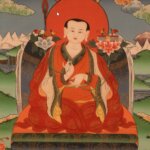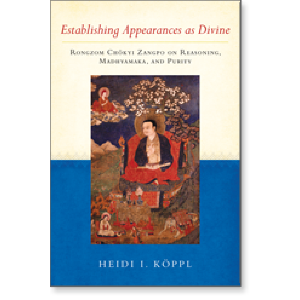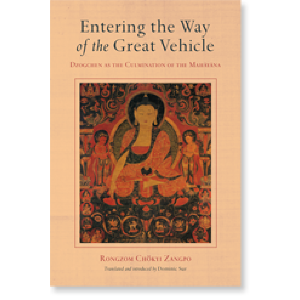
Shambhala Publications: What inspired you to take on this text?
Heidi Koppl: While I was living at my teacher Chökyi Nyima Rinpoche's monastery in the Kathmandu Valley in the early 1990s, Khenpo Chöga Rinpoche was teaching there, and I had the opportunity to attend some of his wonderful classes. This was the first time that I heard about Rongzom and his teachings on the unique Vajrayana view. As I began to study the works of Ju Mipham Rinpoche, I then noticed how he at crucial stages often refers precisely to Rongzom. So I quite quickly developed the wish to study Rongzom's writings myself.
Chökyi Nyima Rinpoche always stresses the importance of pure perception, explaining that all progress on the path of secret mantra depends on our ability to discover and maintain pure perception. During my graduate studies at the University of Copenhagen I therefore decided to concentrate on Rongzoms' works, and especially on this one short text that intrigued me tremendously. In Establishing Appearances as Divine Rongzom sets out to prove, through reasoning, the Vajrayana thesis that all appearances are pure and perfect. Was it really possible to do such a thing? Is it possible to establish a logical foundation for this all-important issue? I really wanted to find out.
Rongzom explains that when we are less disturbed by negative mental factors what appears to us is actually more true than otherwise. We then begin to get the sense that purity and divinity are something to be discovered rather than conjured, and with that can come a great deal of confidence and perspective in one's Vajrayana practice.
SP: How has it helped you in your practice? How is a text like this supposed to influence the mind of a practitioner?
HK: Merely studying and researching the topic of pure perception has helped me to understand just how deep this issue goes. Approaching an understanding of experience as intrinsically pure-in fact, divine-is not a process of cultivating a naïve perspective, and we are not trying to trick ourselves into believing something that actually isn't true. Experiencing the Vajrayana perspective has more to do with understanding the fundamental nature of things and appreciating the fact that everybody's basic nature is pure and perfect. In spite of our fleeting, cloud-like obscurations we can begin to understand this by just paying attention to the way the contents of our experience actually change depending on how we look at things. It's not just that our frame of mind influences the phenomena that appear to us so that, for example, things look better when we are not feeling very nervous or angry. Rongzom explains that when we are less disturbed by negative mental factors what appears to us is actually more true than otherwise. We then begin to get the sense that purity and divinity are something to be discovered rather than conjured, and with that can come a great deal of confidence and perspective in one's Vajrayana practice. The sun always shines, so to speak, even when we cannot see its light coming through the clouds. Merely understanding this can have a profound transformative effect on the way we look at, basically, everything. Both Mipham and Rongzom stress that purity and divinity have always been the case. It is not that we have to make things pure. Perfection is just the way things really are. Gaining certainty in this with the help of the logical arguments set forth by Rongzom can surely take your spiritual practice to another level.
SP: Rongzompa, as he is popularly called, is considered one of the most important figures in the systematization of Nyingma philosophy and practice. How is he discussed and studied today, both in traditional lay and monastic contexts, in Asia and in academia in the West?
HK: Although Rongzom's works are extremely relevant to the study of Varjayana in general, he is mostly referred to in the Nyingma school of Tibetan Buddhism. And among Nyingma scholars Rongzom is often seen and discussed through a Mipham-lens. This is also something I discuss in the book. Sometimes what happens is that we just take a look at what Mipham has to say about Rongzom and then classifiy him accordingly. For instance, though he was of the Prasangika Madhyamaka school, when we look at his own extant works, we notice that Rongzom never refers to Candrakirti or his Madhyamaka. Though he is tremendously venerated, it seems that Rongzom is not very widely studied in modern Nyingma colleges. In academia, Orna Almogi has produced a large survey on Rongzom, but in general very few studies have emerged around him.
SP: What was his influence on later Nyingma writers, like Longchenpa and Mipham Rinpoche?
HK: Mipham Rinpoche himself mentions Rongzom as a central source of inspiration. And, for example, his development of pure vision as a cognitive tool, or as a pramÄá¹a, is clearly influenced by Rongzom. To what degree Longchenpa was influenced by Rongzom is still a very open issue.
SP: There is so little of Rongzompa's work in English, yet almost every Nyingma lama has his collected works on their shelves. Do you have plans to translate any more of his work into English?
HK: Yes, if my work schedule permits, I would very much like to continue translating Rongzom. I am intrigued by Rongzom's unconventional style of explaining important Vajrayana themes through reasoning. His fearless approach of taking up difficult topics that seem inaccessible to our logical intellect is for me a hallmark of his powerful scholarship. It would be a shame if his writings were not translated into English for a modern audience. It seems these days more important than ever to be able to also understand logically the depth and the subtle workings of the Vajrayana practices that we train in on a daily basis.



